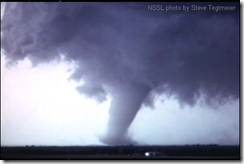Note: This is day 12 of National Preparedness Month. Follow this year’s campaign on Twitter by searching for the #NPM11 hash tag.
This month, as part of NPM11, I’ll be rerunning some edited and updated older preparedness essays, along with some new ones.
# 5833
In a recent survey prepared by the Marist Institute for Public Opinions for the National Center For Disaster Preparedness at Columbia University’s Mailman School of Public Health we learn that 10 years after 9/11 half of all American families still have no disaster plan, and 30% of those with plans lack critical components in their disaster kits.
You can find more details in an Associated Press article that appeared in the WSJ called :
Survey: US public still unprepared for catastrophe
Despite ample evidence to the contrary, far too many Americans have the unrealistic expectation that in a disaster, help would arrive at their door within an hour or two of calling 911.
You can access the executive summary of this survey at:
The American Preparedness Project
Where the US Public Stands in 2011 on Terrorism, Security, and Disaster Preparedness
Disasters, large and small, happen every day around the world. It doesn’t take a pandemic, or an earthquake, or a hurricane to ruin your entire day.
As a paramedic I often came face-to-face with the unhappy results that occur when people are unprepared to deal with an emergency.
I’ve seen people badly injured (and sometimes killed) because they, or someone around them, lacked the knowledge of what to do in an emergency or because they simply didn’t have a proper first aid kit.
This year we saw a destructive tornado season across our southern and Midwestern states, and having lost my roof to one back in 1978, I can assure you there is nothing more abrupt (and likely to make a a lifelong impression) than being struck by one of these monsters in the middle of the night.

This map below shows the areas of greatest danger, but practically all regions of the nation can see tornadoes.

We are just over half way through a very active Hurricane season, and wildfires and drought continue to plague several states in the western and southern part of the country.
And it’s always earthquake season.

Are you ready?
According to this latest poll, many Americans are not. This despite dozens of major disasters (often weather related) that occur every year in this country. Already this nation has seen 10 billion-dollar plus weather disasters in 2011.
And each and every day, thousands of people are injured in automobile, work related, and household accidents.
Everyone should have a well equipped first aid kit in their car, workplace, and home . . . and everyone should know the basics of first aid. If you’ve never taken a first aid course, contact your local chapter of the American Red Cross.
Agencies like FEMA, READY.GOV and the HHS are constantly trying to get the preparedness message out, so that when (not `if') a disaster does occur, human losses can be minimized.
For more information on how to prepare for emergencies the following sites should be of assistance.
FEMA http://www.fema.gov/index.shtm
READY.GOV http://www.ready.gov/
AMERICAN RED CROSS http://www.redcross.org/
At a bare minimum, every household should have a disaster plan, a good first aid kit (and the knowledge to use it), and emergency supplies to last a minimum of 72 hours during a disaster.
Anything less is simply inappropriate.
And personally, I wouldn’t feel comfortable with anything less than a week.
I can’t tell you when the next disaster will strike, or where, or even by what means. But I can assure you that millions of people will be affected by some type of disaster or emergency in the coming year.
And history has shown, the advantage always goes to those who are prepared.
